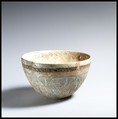Faience bowl
The decorative scheme of this bowl, large petals separated by triangular zones of stacked ferns or pine cones, illustrates the close correspondance between faience and Megarian wares, two types of kiln fired objects ornamented with designs normally associated with silver vessels.While Megarian bowls were made in many places within the Mediterranean basin, faience seems to have been produced solely in Egypt, most likely Alexandria, its artistic and commercial center during the Hellenistic period.The broad appeal of faience bowls, therefore, is attested by their diverse geographical find-spots, such as; the Greek island of Rhodes, Asia Minor (Turkey), Palastine and, Apulia in Southern Italy.
Due to rights restrictions, this image cannot be enlarged, viewed at full screen, or downloaded.

